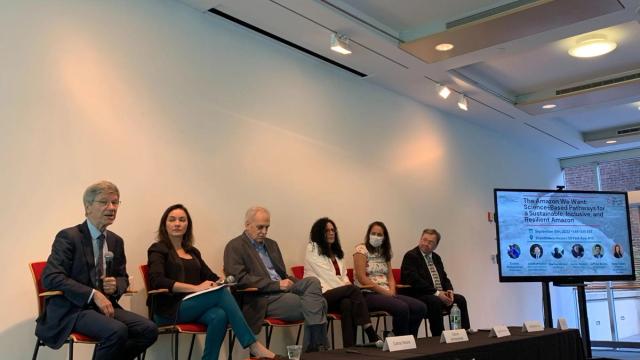Jeffrey Sachs and SPA Members Gather for The Amazon We Want: Science Based Pathways for a Sustainable, Inclusive, and Resilient Amazon
On September 15th, alongside the opening of the 77th United Nations General Assembly, the Science Panel for the Amazon (SPA) organized an event, The Amazon We Want: Science Based Pathways for a Sustainable, Inclusive, and Resilient Amazon. In light of the International Year of Basic Sciences for Sustainable Development, the Science Panel for the Amazon gathered to cover the state of the Amazon since the launch of their landmark Amazon Assessment Report at COP26, what is at stake with the loss of the Amazon, and solutions that can catalyze sustainable development.
The speakers included Prof. Jeffrey Sachs (SPA Convener and President of the Sustainable Development Solutions Network), Dr. Carlos Nobre (SPA Co-Chair and Senior Researcher at the Institute for Advanced Studies of the University of Sao Paulo), Dr. Dolors Armenteras (SPA Co-Chair and Professor at the National University of Colombia), Dr. Marina Hirota (SPA Lead Author and Professor at the Federal University of Santa Catarina), and Dr. Adalberto Val (SPA Science Steering Committee member and Senior Researcher at the Brazilian Institute for Research of the Amazon), with moderation provided by Ms. Ilona Szabó de Carvalho (Co-founder and President of the Igarape Institute).
Jeffrey Sachs highlighted the motivation behind the establishment of the SPA, which began with the 2019 fires and the subsequent adoption of the Leticia Pact. He emphasized the importance of decision-makers utilizing the data behind the 2021 Amazon Assessment Report, compiled by the top scientists in the world, and how policy needs to reflect the data, stating that goals should be practical and achievable. According to Prof. Sachs, “We need to put our knowledge to work to solve problems and set goals on the value, ethics, and the future we want…Most of us don’t know critical things and the scientists that do are often not asked. We need science to create long-term pathways. Luckily, it seems that the decision makers in the Amazon are open to hearing the data and luckily, the Science Panel for the Amazon is leading the way.”
Ilona Szabó thanked Jeffrey Sachs for his points and noted that “if we haven’t paid attention enough as a society, COVID-19 and climate change have shown us how fundamental science is, so let’s work to increase the public policy-science interface.”
Carlos Nobre noted that “more than 95% of the people living in the Amazon want to protect the forest, so the big challenge is why, for the political systems of the Amazonian countries, their policies do not reflect the Amazon we want”. Dr. Nobre detailed the rich diversity of the Amazon, which contains more than 13% of the world’s plant and vertebrate species, and contrasts how the Amazon has been historically presented as a “green hell”. Dr. Nobre presented various climate science data, showing that the Amazon is a key player in the global carbon cycle and crucial for global climate stabilization. It is also crucial forhydrology and water recycling, as well as cultural and ethnic diversity. In summary, science stands with IPLCs showing that the Amazon is indeed a “green paradise” for planet Earth in many aspects.
Dolors Armenteras began her presentation by reminding us that ⅔ of the Amazon is in Brazil and ⅓ is distributed through seven other countries and one national territory, to illustrate how important it is to consider the differences in politics, history, diversity, and policies in those countries. It is also an important reminder that what happens in the northwest of the Amazon is important for the whole system to work. Dr. Armenteras focused on the data behind the many threats that the Amazon is facing, with the largest impact being deforestation, driven mostly by agricultural expansion. She presented the data behind the various other drivers and impacts of deforestation, including mining, elicit crops, oil infrastructure, and dams.
Marina Hirota continued with the conversation focused on the macro effects of these impacts: the tipping points in Amazonian ecosystems. Dr. Hirota presented a map of rainfall-related tipping points,warning that if we continue to decrease the water amount and lengthen the dry season, we are at risk of losing a forest state, even without factoring in the other impacts Dr. Armenteras presented. She addressed the question “how far are we from reaching the tipping point?”: It is well recorded that climate has been changing within the Amazons. However, disturbances are highly heterogeneous, as well as forest responses and changes in composition and structure. We are seeing many changes already, and it’s due to a puzzle of many intersecting factors and the potential projections depend on the disturbances. We should take a precautionary approach, since shifts at any scale can cause tremendous damage to communities, countries, and the planet.
Lastly, Adalberto Val began by emphasizing that the only path forward is by considering the connectivity of the whole region. The Amazon was formed over 65 million years, following the uplift of the Andes. Its history includes significant tectonic and climatic changes, and the adaptations developed to face these variations are written in native species’ genomes. In other words, many of the solutions to climate adaptation are in the history of these genomes. If we burn their environment, we lose this information. The Amazon is a goldmine for the better living of the region’s population and to the entire humanity.
The event ended with a Q&A that covered the role of private markets and of Indigenous peoples and local communities. If you missed it, rewatch the event on the SPA's youtube channel:
